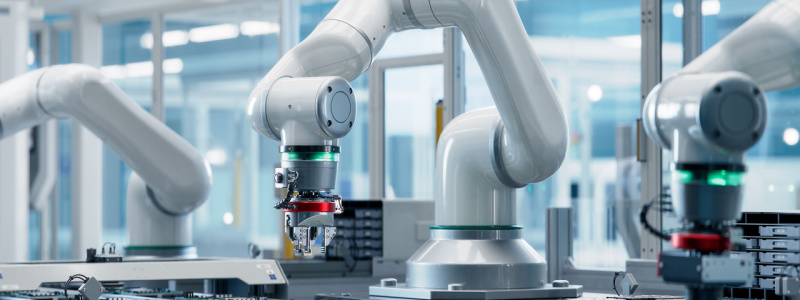Modern robotics: how robots are transforming industries – and everyday life
Posted on: November 24, 2023by Ben Nancholas

The word robot often conjures images from science fiction. People picture humanoid machines that can carry out sophisticated tasks, or that even look – and behave – in a way that’s indistinguishable from a real human being.
While these kinds of depictions have helped fuel people’s fascination with robots, the reality of modern robotics is far more subtle – though no less impressive.
Today, the field of robotics is often complemented by other technologies, such as advanced mechanics, artificial intelligence (AI), and machine learning. More importantly, robots are helping shape the ways we live, work, and explore the world around us.
What are the different types of robots?
Robots come in a wide variety of forms, each designed for specific tasks and environments.
Industrial robots
Industrial robots are at the forefront of the automation revolution and are helping to transform manufacturing processes. Typically equipped with robotic arms and advanced sensors, they are often employed in manufacturing settings to carry out repetitive tasks with precision and efficiency. These robots have redefined assembly lines, ensuring consistent product quality and higher production rates, and have also reduced the need for human hands in hazardous environments. The first robots of this kind were used as early as the 1930s, making them some of the oldest robotics systems still in use today.
Cobots (collaborative robots)
Unlike traditional robots that operate in isolation, cobots are designed to work alongside human operators. They can sense human presence and adjust their actions accordingly. Cobots are often used in areas such as automotive assembly, electronics manufacturing, and healthcare.
Mobile robots
Mobile robots are equipped with mobility mechanisms, allowing them to navigate various environments autonomously. They are frequently used in warehouses for material transportation, in agriculture for crop monitoring, and in search and rescue operations, especially in dangerous locations.
Healthcare robots
The medical field has increasingly embraced robotic technologies to assist in surgical procedures. For example, the da Vinci Surgical System is a robotic arm that assists surgeons in performing intricate procedures with minimal invasiveness. This assistance can help reduce recovery times and improve patient outcomes.
Humanoid robots
Humanoid robots resemble human beings in their form and often in their movements. While still largely in the experimental stage, humanoid robots have the potential to revolutionise care-giving industries.
Robotic toys
Robots can also be a fantastic resource for education and entertainment. Robotic toys like LEGO Mindstorms and educational robots like Bee-Bot introduce children to basic computer programming and problem-solving skills through play-based learning.
Common uses for robotics
It’s clear robotic technologies have applications in a wide variety of areas, from manufacturing and automation to healthcare.
Space exploration
The use of robots in space exploration has expanded human understanding of the universe and broadened the scope of scientific discovery. For example, NASA’s rovers, such as Curiosity and Perseverance, have explored the Martian surface, sending back real-time data and images and paving the way for human travel to Mars in the future.
Transportation
Self-driving cars are one of the pinnacles of robotic technologies. Robotic vehicles – equipped with advanced AI algorithms and mechanical sensors – have the potential to reduce traffic accidents, lower emissions, and provide newfound mobility for people who would otherwise struggle to get out and about.
Agriculture
Agricultural robots are designed to perform specific tasks like planting, watering, maintaining, and harvesting crops. These robots can reduce labour costs while creating more sustainable farming practices. For example, they can save water through more efficient watering systems and minimise the need for harmful pesticides.
Household chores
In many cases, robotic technologies have been seamlessly integrated into people’s daily lives. Robotic vacuum cleaners, such as the Roomba, navigate homes, keeping floors clean while requiring minimal human intervention. This application of robotics is a great example of how robots can free up people’s time for more meaningful activities.
The future of robotics
New robot technologies are advancing at a rapid pace, and the boundaries of what robots can achieve are continually expanding.
Artificial intelligence and machine learning
Technological advances and breakthroughs in artificial intelligence and machine learning play an essential role in enabling robots to adapt to changing environments and learn from their experiences. Machine learning algorithms, for example, are working to ensure robots can analyse data, make informed decisions, and improve their performance over time. As the technologies evolve, robots will become capable of more complex tasks and interactions.
Social robots
Social robots are an emerging area of robotics and have potential applications in areas such as therapy, education, and even companionship. These machines are designed for human-robot interaction, and aim to be able to understand – and respond to – human emotions.
Pandemic response
The COVID-19 pandemic highlighted the value of robotic technologies in healthcare and as aids in crisis situations. For example, robots were used to disinfect hospitals, deliver supplies, and even provide company to those in quarantine.
Develop expertise in the science underpinning robotics
Learn more about the technologies that make robotics possible by studying the 100% online MSc Computer Science at Keele University. This flexible, part-time programme has been designed for ambitious individuals who may not have studied computer science previously, as well as computer science professionals who want an academic qualification to accelerate their career progression in information technology.
You’ll develop and extend the practical skills you need for designing, building, deploying, and evaluating software and computer applications in a variety of contexts. You will also learn programming and web languages including Python, Java, and XML, work with mobile apps, and learn to develop modern software systems and applications.
Key areas of study include:
- design and programming
- computer science fundamentals
- user interaction (UI) design
- statistical data analytics and databases
- software engineering
- web technologies and security
- advanced programming techniques.
